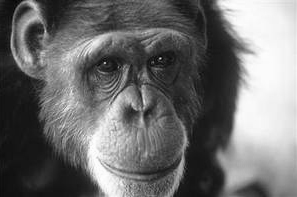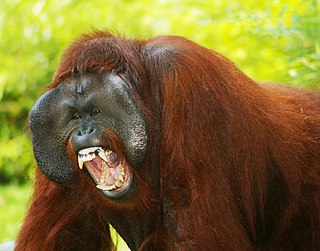
Central Washington University (CWU) is a public university in Ellensburg, Washington. Founded in 1891, the university consists of four divisions: the President's Division, Business and Financial Affairs, Operations, and Academic and Student Life (ASL). Within ASL are four colleges: the College of Arts and Humanities, the College of Business, the College of Education and Professional Studies, and College of the Sciences. CWU is considered an emerging Hispanic-Serving Institution and 15 percent of its students are Hispanic.

Neam "Nim" Chimpsky was a chimpanzee and the subject of an extended study of animal language acquisition at Columbia University. The project was led by Herbert S. Terrace with the linguistic analysis headed up by psycholinguist Thomas Bever. Within the context of a scientific study, Chimpsky was named as a pun on linguist Noam Chomsky, who posits that humans are "wired" to develop language.
Irene Maxine Pepperberg is an American scientist noted for her studies in animal cognition, particularly in relation to parrots. She has been a professor, researcher and/or lecturer at multiple universities, and she is currently an Adjunct Research Professor at Boston University. Pepperberg also serves on the Advisory Council of METI. She is well known for her comparative studies into the cognitive fundamentals of language and communication, and she was one of the first to work on language learning in animals other than primate species, by extension to a bird species. Pepperberg is also active in wildlife conservation, especially in relation to parrots.

Washoe was a female common chimpanzee who was the first non-human to learn to communicate using American Sign Language (ASL) as part of an animal research experiment on animal language acquisition.
Comparative psychology is the scientific study of the behavior and mental processes of non-human animals, especially as these relate to the phylogenetic history, adaptive significance, and development of behavior. The phrase comparative psychology may be employed in a narrow and a broad meaning. In its narrow meaning, it refers to the study of the similarities and differences in the psychology and behavior of different species. In a broader meaning, comparative psychology includes comparisons between different biological and socio-cultural groups, such as species, sexes, developmental stages, ages, and ethnicities. Research in this area addresses many different issues, uses many different methods and explores the behavior of many different species from insects to primates.

Research into great ape language has involved teaching chimpanzees, bonobos, gorillas and orangutans to communicate with humans and each other using sign language, physical tokens, lexigrams, and imitative human speech. Some primatologists argue that the use of these communication methods indicate primate "language" ability, though this depends on one's definition of language. The cognitive tradeoff hypothesis suggests that human language skills evolved at the expense of the short-term and working memory capabilities observed in other hominids.
The Chimpanzee and Human Communication Institute (CHCI) was located on the campus of Central Washington University in Ellensburg, Washington. CHCI included a sanctuary for chimpanzees who have learned to communicate with humans and each other using American Sign Language. CHCI's director was Mary Lee Jensvold. It was founded by former co-directors Roger Fouts and Deborah Fouts. The institute was closed in 2013 when the remaining chimpanzees were transferred to facilities in Quebec, Canada and the building the facility was housed in, was demolished in 2018. Portions of the specialized structures used to house the chimps were dismantled and moved to the Chimpanzee Sanctuary Northwest in Cle Elum, for future use.
The Mind of an Ape is a 1983 book by David Premack and his wife Ann James Premack. The authors argue that it is possible to teach language to (non-human) great apes. They write: "We now know that someone who comprehends speech must know language, even if he or she cannot produce it."
Loulis is a chimpanzee who has learned to communicate in American Sign Language.
Deborah Fouts was the co-director of the Chimpanzee and Human Communication Institute (CHCI). CHCI was the home of Washoe, the first non-human to acquire a human language, and three other chimpanzees who use the signs of American Sign Language to communicate with each other and their human caregivers. She is an Adjunct Assistant Professor of Psychology (Research) at Central Washington University in Ellensburg, Washington. She is married to former co-director, now retired Roger Fouts.

Roger S. Fouts is a retired American primate researcher. He was co-founder and co-director of the Chimpanzee and Human Communication Institute (CHCI) in Washington, and a professor of psychology at the Central Washington University. He is best known for his role in teaching Washoe the chimpanzee to communicate using a set of signs taken from American sign language.
Anne C. Zeller is a physical anthropologist who specializes in the study of primates. She received her M.A.(1971) and Ph.D (1978) from the University of Toronto.
Comparative cognition is the comparative study of the mechanisms and origins of cognition in various species, and is sometimes seen as more general than, or similar to, comparative psychology. From a biological point of view, work is being done on the brains of fruit flies that should yield techniques precise enough to allow an understanding of the workings of the human brain on a scale appreciative of individual groups of neurons rather than the more regional scale previously used. Similarly, gene activity in the human brain is better understood through examination of the brains of mice by the Seattle-based Allen Institute for Brain Science, yielding the freely available Allen Brain Atlas. This type of study is related to comparative cognition, but better classified as one of comparative genomics. Increasing emphasis in psychology and ethology on the biological aspects of perception and behavior is bridging the gap between genomics and behavioral analysis.
The Fauna Foundation is the only chimpanzee sanctuary in Canada. Located just outside Chambly, on the South Shore of Montreal, the story of Fauna started in 1990 by Gloria Grow and Dr. Richard Allan on their 150-acre (0.61 km2) farm. Later in 1997, it became the Fauna Foundation. Its primary objective, the rescue and care of chimpanzees who have been used in research, began in the wake of the shutdown of LEMSIP.
Barbara Boardman Smuts is an American anthropologist and psychologist noted for her research into baboons, dolphins, and chimpanzees, and a Professor Emeritus at University of Michigan, Ann Arbor.

Josep Call is a Spanish comparative psychologist specializing in primate cognition.
David Andrew Whiten, known as Andrew Whiten is a British zoologist and psychologist, Professor of Evolutionary and Developmental Psychology, and Professor Wardlaw Emeritus at University of St Andrews in Scotland. He is known for his research in social cognition, specifically on social learning, tradition and the evolution of culture, social Machiavellian intelligence, autism and imitation, as well as the behavioral ecology of sociality. In 1996, Whiten and his colleagues invented an artificial fruit that allowed to study learning in apes and humans.
METI International, known simply as METI, is a non-profit research organization founded in July 2015 by Douglas Vakoch that creates and transmits interstellar messages to attempt to communicate with extraterrestrial civilizations. It is based in San Francisco, California.
Beatrix Tugendhut Gardner was an Austrian zoologist who became well known for the research that she conducted in the United States. She is most well known for her sign language studies with Washoe the chimpanzee, who was the first ape to learn sign language.
Crickette Marie Sanz is a professor, naturalist, explorer, and field biologist notable for her work on primates and great apes in the Republic of the Congo.





